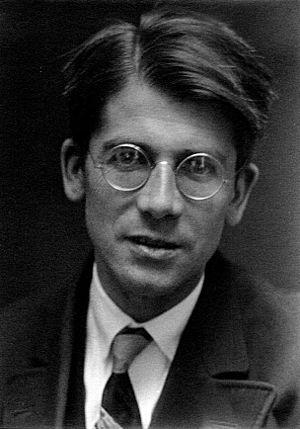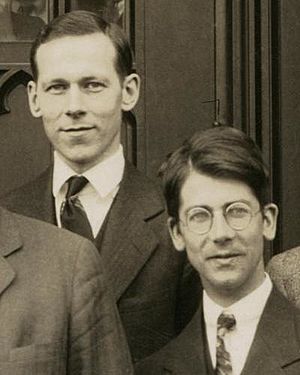Friedrich Hund facts for kids
Quick facts for kids
Friedrich Hund
|
|
|---|---|

Friedrich Hund, Göttingen (~ 1925)
|
|
| Born | 4 February 1896 |
| Died | 31 March 1997 (aged 101) |
| Nationality | German |
| Scientific career | |
| Fields | physics |
Friedrich Hund (born February 4, 1896 – died March 31, 1997) was a German physicist. He was born in Karlsruhe and is famous for his important work on atoms and molecules.
Hund worked at several universities during his long career. These included the Universities of Rostock, Leipzig, Jena, Frankfurt am Main, and Göttingen. He was also a member of the International Academy of Quantum Molecular Science.
He wrote more than 250 scientific papers. His work greatly helped us understand quantum theory. This theory explains how tiny particles like atoms behave. He also studied the structure of atoms and how light comes from molecules. The "Hund's rule" is named after him. In 1926, he also discovered something called the tunneling effect.
Friedrich Hund's Life and Work

Friedrich Hund worked with many famous physicists. These included Schrödinger, Dirac, Heisenberg, Max Born, and Walter Bothe. He was an assistant to Max Born, helping with new ideas in quantum mechanics.
Hund studied mathematics, physics, and geography. He went to universities in Marburg and Göttingen. In 1925, he became a private lecturer in theoretical physics at Göttingen. Later, he became a professor at Rostock in 1927 and Leipzig in 1929. After World War II, he taught at Jena in 1946, Frankfurt/Main in 1951, and then returned to Göttingen in 1957.
He also spent time in Copenhagen in 1926, working with Niels Bohr. In 1928, he gave lectures about the atom at Harvard University in Cambridge, Massachusetts.
For his 100th birthday, a special book was published. It was called "Friedrich Hund: Geschichte der physikalischen Begriffe" (History of Physics Terms). The book was published in 1996.
Friedrich Hund was made an honorary citizen of Jena. A street in Jena was named after him. Since 2004, a part of the new Physics Department building in Jena has the address Friedrich-Hund-Platz 1. The Institute for Theoretical Physics at the University of Göttingen also carries his name.
Hund's Rules and Cases
Friedrich Hund is well-known for two important ideas in physics and chemistry. These are the Hund's cases and the Hund's rules.
- Hund's cases describe how different parts of a molecule's spin and movement combine. This is important for understanding spectroscopy, which studies how light interacts with matter.
- Hund's rules help explain how electron configurations work. They tell us how electrons arrange themselves around an atom. In chemistry, the first of Hund's rules is very important. It is often simply called "Hund's rule." This rule helps predict how atoms will bond and react.
Images for kids
See also
 In Spanish: Friedrich Hund para niños
In Spanish: Friedrich Hund para niños


